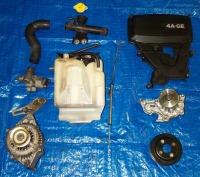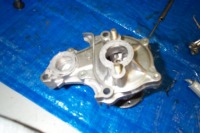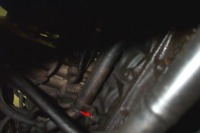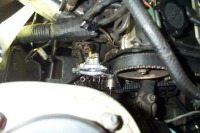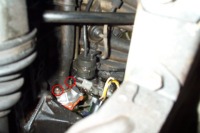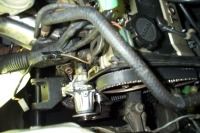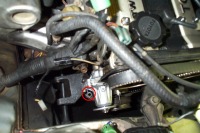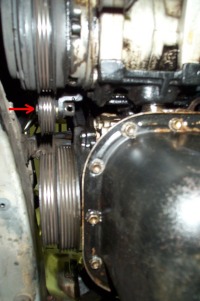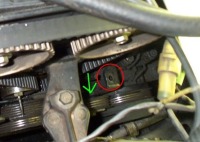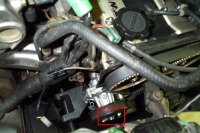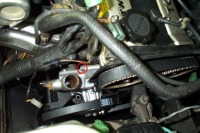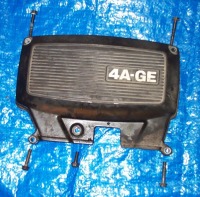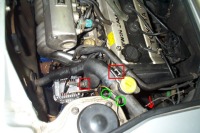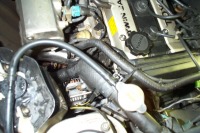
Water Pump Change (Part 2/3)Installation of Water Pump 1) Time to clean everything up (via Simple Green, WD40 & Carb Cleaner) and organize all the parts. Here's what all you should have:
2) Permatex the 2 o-rings on the suction cover (update: ended up not using the o-ring on the left side of this picture, I just permatex'd the crap out of it.) Note: If you have removed the timing belt it is not necessary to put the suction cover and water pump on separately. You can bolt the 2 together, and then bolt the assembly to the block.
3) Loosen the coolant pipe by removing the 10 or 12mm bolt shown here, that leads from the suction cover to the thermostat housing:
4) Very carefully, place the suction cover onto the block and into this pipe. Make sure that the o-ring that attaches to the block didn't shift on you and that you still have some permatex back there. Secure (don't tighten) the cover to the coolant pipe, either from up top.... or below:
5) Permatex the crap out of the water pump:
6) Very carefully, again, place the pump over the suction cover. Secure the pump to the cover by using a couple of the 10mm bolts to hold them together. Then line up the assembly with the block, and bolt it down with the 10mm (the longest one) and the 12mm bolts. (Note: The 10mm bolt for the assembly is for the uppermost hole.) Tighten down everything securely, according to the torque specs in the BGB, 9 & 11 ft-lbs I believe. Also, don't forget to install the oil dipstick guide, since it attaches to the water pump. Put a lil RTV on its gasket.
7) At this point I would suggest to reinstall the coolant inlet housing onto the engine and then taking a break. This way after a couple hours of letting the RTV cure, you can check the water pump for leaks by simply filling the system with water. If you notice any leaks from simply filling it up, you will not have wasted time putting everything else back together. Use the new o-ring and gasket that came with the pump assembly when installing the inlet housing. Also, use some RTV on the surfaces. 8) Once you are sure that the pump isn't leaking, you may continue putting everything back on. Start with timing cover #2. Again, here are the 2 bolts that need to be replaced:
9) Next up is the AC idle pulley. Insert the bolt and it's washer (circled): And then the pulley, 'big' washer, and the nut. Tighten the nut down until the pulley is secure, and then make sure the hole in the bolt head is aligned with the hole in the top of the bracket. The red-circled hole. Then, thread the long 15mm bolt through the idle pulley bolt. No need to tighten it down fully, just get the threads so they atleast pass all the way through the bolt head. 10) Next, install the water pump pulley and bolts. Don't worry about tightening the bolts for now.
11) Install the belts. Water pump and alternator belt go on the innermost crank pulley, then AC belt. Go ahead and tighten the AC belt, by pushing the idle pulley up while under the car. You may need to loosen the nut a little. I tried prying the pulley up with a big screwdriver, but the best method I found was just by pushing it up with your free hand, and then tightening the nut down with your other hand. Use one of them belt tensioner gauges (or index finger) to make sure the belt isn't too loose or too tight. Get out from under the car, and tighten down the AC idle pulley bolt (the long 15mm one). 12) Install the water inlet housing with new gaskets.
12) Re-install alternator. In the below pic, the above mentioned AC idle pulley bolt is shown in the red square. The green arrow is pointing to the alternator of course. If you need assistance with the alternator refer to my alternator write-up.
13) Reinstall Timing cover #3. Again, here's a picture of it uninstalled so u can figure out where all the bolts are located. The one in the bottom middle is the toughest to get to.
14) Reinstall radiator cap hardware and hose. Don't forget to reconnect those 3 wire connectors. Also ground the yellow/black wire onto the body through one of the green circled bolts.
15) And finally, the coolant reservoir:
Goto Page 3 for the coolant flush process... |
Home • Links •
Email
(remove NOSPAM from resulting email address)
Thanks for Visiting! - Eric Southers
Disclaimer: This web page in no way replaces
the MR2 repair manual. Follow what it says before me. The purpose of
this page is to give you a better pictorial description of what to do.
I cannot be held responsible for any mishaps caused by this web page.
